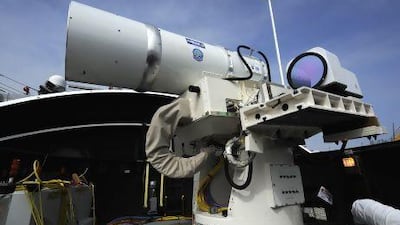DUBAI // The Arabian Gulf's extreme weather makes its waters ideal for rigorous testing of the US Navy's newest weapon.
The Laser Weapon System uses high-energy beams instead of bullets or missiles, and could provide a crucial defence blanket against attacks from enemy ships and drones, experts say.
The prototype will undergo year-long tests when installed early next year on the USS Ponce, a support vessel for the navy's fifth fleet in Bahrain.
"The harsh environment and relevant operational mission provide ideal conditions to evaluate long-term system performance," said Lt Marissa Myatt, a US fifth fleet spokeswoman.
"It is designed to counter asymmetric threats including swarming small boats, UAVs [unmanned aerial vehicles], and other low-cost, widely available weapons.
"While aboard Ponce, the system will be available for operational employment as a self-defence system while giving the navy an opportunity to test the system in a real-world environment."
The beam from a 100-kilowatt laser can track and lock on to moving vessels, and disable or destroy small boats and surveillance drones.
It will greatly change maritime security, experts believe, since it cannot be outmanoeuvred by small, armed speedboats.
This made it ideal for crowded sea lanes such as the Strait of Hormuz, which is vulnerable to shutdown by Iran's fast patrol boats. There are also concerns about terror strikes on offshore oil installations.
"There have been concerns about swarming with small boats, mines and attacks by small submarines," said retired rear admiral Christian Giermann, a former adviser to the UAE Chief of Naval Forces.
"Once the target data is available, the target can be dealt with. This new weapon can guard against any aggressive action and threat. Better and advanced technology will also help sailors have more control with the weapon."
Vigilance has always been critical off the UAE coast because of the strait, through which a fifth of the world's oil exports pass.
Initial test reports showed the laser system needed trials in severe weather conditions because sand, dust and fog can reduce its effectiveness. The Arabian Gulf provides all those conditions, as well as high heat and humidity.
The weapon has other benefits.
"The great advantage of a laser weapon is that it is not reliant upon traditional ammunition supply such as missiles or bullets," said Ian Millen, the director of intelligence at Dryad Maritime, a specialist intelligence service.
"A laser system can operate in a sustained way as long as there is a power supply to support it."
The estimated cost of a laser shot is about US$1 (Dh3.67) as opposed to the hundreds of thousands of dollars it costs to fire a missile.
The system offers a range of beams, from the non-lethal used to dazzle and blind vessels, to those that disable missiles and incinerate targets.
"The navy considers the solid-state laser a revolutionary technology that gives us an extremely affordable, multi-mission weapon with a deep magazine and unmatched precision, targeting and control functions," Lt Myatt said.
rtalwar@thenational.ae

New laser gun put to the weather test
The Laser Weapon System uses high-energy beams instead of bullets or missiles, and could provide a crucial defence blanket against attacks from enemy ships and drones, experts say.
Most popular today

